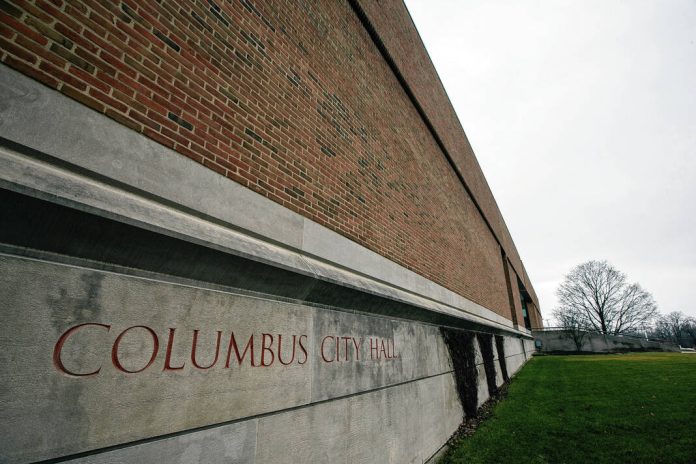The Columbus City Council has approved the first reading of two ordinances that annex and rezone land where an applicant plans to build a single-family residential subdivision on the eastern edge of the city.
Both votes were 8-0. Councilman Jerone Wood was absent.
The Columbus Plan Commission forwarded a favorable recommendation to the council on both requests with a 10-0 vote during a meeting on April 10.
Snitko Holdings LLC is asking to annex and rezone 15 acres of property at 3361 N. Talley Road in Clay Township. The applicant requests the area be rezoned from AP (Agricultural: Preferred) to RS1 (Residential: Single Family 1). The RS1 designation is the city’s lowest density residential zoning district, according to city/county planning director Jeff Bergman.
The applicant, David Smith, told the council his plan would be for there to be 12 homes on lots about 1 acre each, joining one home already in the area. He added there would be a retention pond on a green space to deal with drainage.
Smith said some of the lots will be sold to those who have already expressed interest, some will be publicly listed and others will be “spec” homes.
“So it’ll be about 12 additional homes, so maybe we’d target keeping 25% or something for ‘spec’ homes or something like that,” according to Smith, who later said there will be minimum requirements that will require that the homes cannot be below a certain square-footage.
On the annexation question, the council was to determine whether the 15 acres would be an appropriate addition to the city based on its contiguity to the city limits and availability of municipal services. They also looked at a list of 10 adopted city policies on annexation adopted in 1990, particularly two that say that “contiguous lands needed for orderly growth and implementation of the City’s comprehensive plan should be a part of the city” and that “contiguous lands which are likely to be redeveloped in the relatively near future should be a part of the city.”
The city’s comprehensive plan identifies the future land use for the area as residential.
On the rezoning questions, council members were to decide what the most appropriate allowable uses are on the property, along with the most appropriate intensity for that development, Bergman said.
One point of discussion that was a focus in the plan commission meeting and this week is that a significant part of the site is located in FEMA Zone A, an area of unmapped flood hazards. However, the Indiana Department of Natural Resources (IDNR) “determined that no floodway is present and has provided a base flood elevation as a basis for the flood protection of any structures,” according to a planning department staff report. The structures would have to be 2 feet above the base flood elevation at a minimum, Bergman said, noting there’s an amount of upstream drainage that comes across the property.
Because the property is in the floodplain, the vast majority of the homes will be precluded from having basements, Bergman said, with the exception of the south-east corner of the area.
“There are processes through FEMA where the whole property could be filled, or portions of the property could be filled, and remap outside of the floodplain, which could potentially enable basements,” Bergman said.
The property is near an unnamed tributary connected to the Sloan Branch of Clifty Creek. Standing water sometimes found on the property comes from Sloan Branch.
During public comment in April, community members expressed concern primarily about drainage and flooding.
According to Smith, the development of the new addition could begin at the end of the year, but more likely will happen next year. It partly coincides with improvements to Talley Road the city is undertaking that are expected to begin in 2026.
“With those Talley Road improvements, not only will the road be better for vehicle traffic, but we’ll also have a shared use path to accommodate better walking and bike traffic,” Bergman said.
Councilman Kent Anderson said the area near the property is “great land where we can actually grow as a city,” and that “it’s great to see something taking place in that corner.”
He also asked how the city deals with water management concerns, which Bergman said will be addressed as the process goes on.
Next, Snitko will submit preliminary plat that will illustrate how the property would be divided, where public streets would be and how they would address stormwater and other public improvements. That would then be reviewed by the plan commission and if approved, Snitko would submit construction plans and a final plat that would go into further detail. Those construction plans at that point would be reviewed by several groups including the planning department, city engineer’s office, city utilities, and the fire department.
“Bottom line is there’s an extremely thorough process to handle these exact issues,” Anderson said.
Councilman Chris Bartels said he was “thankful for anytime we have new construction being built for homes.”
During public comment, community member Zack Patchett said he supported the annexation, but not the development, in part because the homes likely wouldn’t be able to have basements.
“A lot of these people are going to be looking for building larger houses with large acreage and basements are usually pretty desirable for that kind of crowd,” Patchett said, adding he thought a more efficient usage of the land would be for a multifamily development.
“That kind of middle housing option is more rare,” Patchett said.
Council President Frank Miller later said that there’s a lack of a variety of types of housing that could be partly addressed by homes Snitko is planning.
“There’s always a need for the affordable housing, but you’ve got residents or potential residents that have wants and wishes for something larger, something bigger, and we’ve got to be able to afford those people what they want,” Miller said.
The second reading of both ordinances will come before the council during their May 21 meeting.





